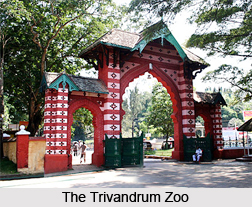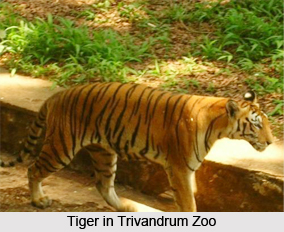 Established in 1857, Trivandrum Zoo is centrally located in Thiruvananthapuram, capital of Kerala. It occupies 55 acres of woodland, lakes and lawns, in a well-planned botanical garden. Trivandrum Zoo is one of the oldest zoos in India.The Maharaja of Travancore is credited with the establishment of this zoo. It originally had archetypal iron-barred enclosures. Later under a modernization project which started in 1995, the old iron enclosures were altered to include more rooms and more spacious natural enclosures. This was done with the objective to make the animals feel at home. The local and the state government of Kerala along with the Central Zoo Authority have undertaken the responsibility to redesign this zoo.
Established in 1857, Trivandrum Zoo is centrally located in Thiruvananthapuram, capital of Kerala. It occupies 55 acres of woodland, lakes and lawns, in a well-planned botanical garden. Trivandrum Zoo is one of the oldest zoos in India.The Maharaja of Travancore is credited with the establishment of this zoo. It originally had archetypal iron-barred enclosures. Later under a modernization project which started in 1995, the old iron enclosures were altered to include more rooms and more spacious natural enclosures. This was done with the objective to make the animals feel at home. The local and the state government of Kerala along with the Central Zoo Authority have undertaken the responsibility to redesign this zoo.
Objectives of the Trivandrum Zoo
The zoo was initially planned for recreational visits but with increased deforestation and adverse effects on wildlife due to human encroachment, the zoo is primarily aimed at preservation of endemic and endangered species in the Western Ghats.
Animal Species Protected in Trivandrum Zoo
The Trivandrum Zoo has shown gradual improvement in animal count since it"s commencement. Improved accommodation thus became consequential to increased animal count, during the years 1880 to1890. This can be exampled by a magnificent house similar to the cages of the Zoological Gardens of London. The zoo also housed rare animals as the Ourangoutang, Malay Tapir and Rhinoceros in those early days. By 1935, it thus became imperative for the zoo to expand. Presently, the zoo has the potential to preserve fairly representative collection of animals and birds both indigenous and exotic.
 The Thiruvananthapuram Zoo provides shelter to 82 species from all around the world. Indigenous species in the zoo include lion-tailed macaque, Nilgiri langur, Indian rhinoceros, Asiatic lion, Royal Bengal tiger, white tigers, leopard as well as Asiatic elephants. Animals from Africa include giraffes, hippos, zebras and Cape buffalos. The zoo also houses a wide variety of fauna from Ethiopia and Australia.
The Thiruvananthapuram Zoo provides shelter to 82 species from all around the world. Indigenous species in the zoo include lion-tailed macaque, Nilgiri langur, Indian rhinoceros, Asiatic lion, Royal Bengal tiger, white tigers, leopard as well as Asiatic elephants. Animals from Africa include giraffes, hippos, zebras and Cape buffalos. The zoo also houses a wide variety of fauna from Ethiopia and Australia.
The birds preserved in the zoo are ostrich, scarlet macaw, green winged macaw, white spoonbill, common crane, cassowary, white necked crane, sulphur crested cockatoo, white ibis, black necked cranegrey heron, alexandrine parakeet, blossom headed parakeet, roseringed parakeet, gray pelican, moutached parakeet, emu, brahminy kite, king vulture and white backed vulture to name a few.
A reptile enclosure was also constructed in the zoo to include snakes from 12 different categories for preservation as well as display. It was recently provided with a modernized snake nest to include more snakes.
To preserve the anacondas, special arrangements were made in the zoo. The zoo authorities arranged separate cages for small and big ones. They also checked the water and other ecological factors in the cages. Since paint and cement are allergic to anacondas, the fishes were allowed to live in the cage for few months. The cages were inspected by the Chennai Animal Quarantine and Certification Department, along with the health of the snakes. Based on their positive report to the government, the anacondas were allowed to take shelter in Trivandrum Zoo. The roofs made of fiber glasses allow direct sunlight into the cages. The micro chip under the neck skin of each anaconda monitors the metabolism of it"s body regularly and keeps a computerized record of it. The temperature inside each cage is adjustable and CC TV cameras are installed to keep daily activities of the snakes in check. Some of the reptiles in this zoo are gharial, mugger crocodile, bamboo pit viper, red sandboa, king cobra and crowned river turtle. This snake farm includes both poisonous and non-poisonous snakes.
Although the zoo is aimed at preserving various species of flora and fauna, it is still evident that the condition in which the animals are kept by the zoo authorities of the western side is unbearably distressing. But in spite of it"s flaws the zoo continues to be a natural heritage of Kerala which is frequently visited by tourists.
Visiting Information
May to September is generally the best period to visit Trivandrum Zoo. The zoo is accessible via Mahatma Gandhi Road in Thiruvananthapuram. Nearby places which can be visited by tourists are the Napier Museum, art gallery and a park.
Related Articles:
Kerela Flora and Fauna
Asiatic lion
Royal Bengal tiger
King Cobra
Western Ghats
Thiruvananthapuram















